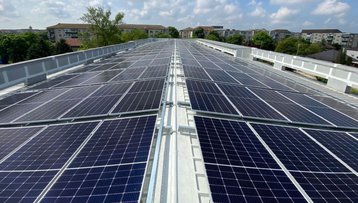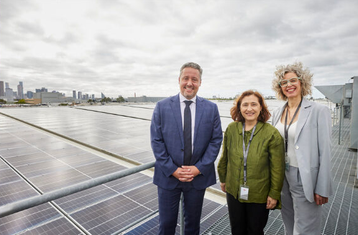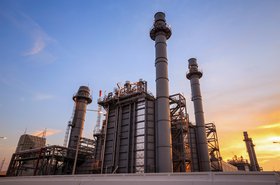While not a de facto choice – especially for large hyperscale facilities – on-site solar is growing in popularity as companies look to boost their green credentials and save money against high energy costs.
Operators large and small have deployed solar panels to the rooftops of their facilities. But what do companies need to know when looking at deploying rooftop solar?
On-site solar: time to shine
European operator Penta Infra has solar PV deployed at around half of its sites – a mix of rooftop and facade, both “As a large footprint single-story more in the planning pipeline. Stijn Daniels, chief development officer at Penta Infra, said the company is adding solar where it makes sense, to the point where it is becoming fairly standard within its energy portfolio.
“In Dusseldorf, we have an office building where the roof was end of life,” he says. “Now we have a new roof that we’re going to place solar panels on. But in Amsterdam, where we are basically renovating a very old data center, there’s just no space on the roof. We’re fully building it out for the chillers, and there’s no space for solar on the facade.”
Nlighten, another European operator, currently has one rooftop solar deployment at its Milton Keynes site in the UK. The company completed the 4,500 sqm (48,437 sq ft) rooftop replacement retrofit in November 2023 in partnership with Ithaca Roofing and Bauder. The site features more than 1,000 panels, able to generate up to 500kW.
“As a large footprint single-story building, it was an ideal platform for us to trial a solar project for one of our data centers,” says Francesco Marasco, VP energy operations and sustainability at nLighten. “We had already identified the site as one where we planned a progressive build-out project, and replacing the existing original aging roof made sense as a first step before improving the interior and M&E of the site.”
Nlighten says there have been periods when the solar panels have covered the entire needs of the facility “for several minutes of the day.” The company says it is currently considering other options for solar PV – in some cases for larger deployments – but is yet to make any further decisions.
Equinix deployed a 1MW rooftop solar system at its ME1 facility in Melbourne, Australia, in 2024. The company has another 800kW of solar across its other Aussie sites. The colo giant also has rooftop solar at sites in other countries, including its PA13x facility in Paris, France.
Rooftop solar can be found at data centers all over the world, including at those operated by Yondr, Stellium, and Iomart in the UK; Prosoluce and Denv-R in France; AirTrunk in Malaysia; NextDC in Australia; Meta and Singtel in Singapore; Aruba in Italy; Digital Realty in India; and Orange in Poland, Romania, the Ivory Coast, and Burkina Faso.
Digital Realty currently has 19 sites hosting behind-the-meter solar installations totaling 9.8MW capacity. The company tells us it has an “additional roadmap to continue to grow, with additional projects in the planning or construction stage.”
Most of the company’s deployments are fairly small, often in the 100kW range and covering less than 1 percent of a facility’s load. That figure can go as high as 20 percent in Kenya at its icolo facilities, though these are relatively small in terms of overall capacity. The company also has deployments in markets in Europe and in Singapore. In South Africa, its Teraco unit has approximately 6MW of rooftop solar across its sites in Cape Town, Johannesburg, and Durban.
“[Solar] is certainly an important consideration,” says Aaron Binkley, VP, sustainability at Digital Realty. “It’s a key part of our approach on building, powering, and operating sustainable data centers.”
Iron Mountain’s 830,000 sq ft (77,109 sqm) NJE-1 facility, a former New York Times printing facility in Edison, New Jersey, was retrofitted with a rooftop solar in 2020. At the time Iron Mountain said the 7.2MW system – which it claimed was the largest such deployment at a data center globally – would cover around 15 percent of the 30MW site’s needs.
The company tells us the installation generates more than 9 million kWh annually, but concedes such a setup isn’t practical in every market. It has signed distributed solar deals in markets such as London and Amsterdam in lieu of data center rooftop projects.
Solar in retro-fits vs newbuilds
Integrating solar panels in the design of new purpose-built data centers is obviously much easier than retrofitting to an existing facility. With new builds, operators can ensure PV systems are optimized to generate the most energy; with retrofits, operators are trying to build around existing critical plant infrastructure.
“With legacy sites, there are bigger wins from doing other sustainability-led projects; looking at the efficiency of the systems and types of cooling or UPS,” suggests Richard Clifford, director of solutions at data center consultant Keysource. “But the best time to deploy solar is when you’re upgrading some of the electrical infrastructure, and then you can make some changes or refresh.”
In Digital’s most recent development in Australia, solar was built in from the start. But the company isn’t afraid of a retrofit.
“All of our solar in Singapore was built on operating data centers,” says Binkley. “Some of our projects in Australia are new construction, but others were retrofits on existing buildings.”
He notes that in certain locations, such as Australia and Singapore, solar is becoming part of the company’s standard design.
“The way we’ve been focusing on it has been how do we increase adoption and portfolio coverage?” says Binkley, “Even if it’s a small system, how do we build our experience and build the standardization so that we can build it out across more sites over time?”
He continues: “We might say we want all new development projects in one market to include solar. And then we can build that in as part of our design, and maybe we can redesign the cooling equipment so there’s more rooftop space to accommodate solar. That could be an example of how we would massage our designs to accommodate more solar in a market where it’s attractive.”
Space is the biggest consideration when looking at rooftop solar. Many data centers feature large amounts of plant equipment, such as chillers and generators, on the roof, meaning there is simply not enough space to justify a solar deployment. And those that do today, might not in the future if the operator has any desire to expand capacity and add more chillers.
Integrating panels into the design of a new build means the solar system and other plant equipment can be placed and oriented in a way that is optimized.
Data centers have far greater cooling requirements than other industrial buildings, says Anthony Maguire, managing director of energy consulting firm Longevity Power, which means more HVAC equipment on the roof.
Including solar PV at the planning stage ensures that there is adequate roof space for solar panels, and also minimizes localized shading from external ducts and other features. He also notes solar panels can increase the thermal load of a roof, so it’s important to carefully model the installation in advance.
“Data centers must prioritize space for essential chillers and generators to function effectively,” notes Chris Pennington, Iron Mountain’s director of energy and sustainability. “Only after these systems have been allocated sufficient room for current and future needs should solar panel installation be considered.”
“The use of space now and in the future is an aspect that needs to be considered when evaluating a building retrofit project,” warns nLighten’s Marasco. “With newbuilds, the positioning of the M&E equipment is optimised on a blank canvas. In a refurbishment, the use of space is somewhat constrained by the building footprint, plant location, and building orientation.”
“Once an organisation has determined if they have the required roof space for solar panels, they must then assess if this will pose any physical risk to the site,” says Pennington. “Installing solar panels often requires roof penetrations to secure them to the building. These holes should not be made over data hall areas, as they may increase the risk of roof leaks.”
Key considerations for putting in rooftop solar
Weight is a consideration for any rooftop solar deployment. Solar PV systems add around 3-6 lbs per square foot to the dead load of a roof – with a single panel often weighing some 40 pounds or more – and up to 45 lbs at specific attachment points.
If a ballasted system is installed on a flat roof, it may add up to 20-30 lbs per square foot. Light-weight options are available – such as panels from perovskite – but aren’t as common and are often costlier.
There are two main ways to fix a PV system to a flat roof; ballasted or mechanical. A ballasted system weighs the panels down to the roof, while a mechanical system is fixed either by penetrating the roof or bonding with the roof membrane with bitumen.
“Roof leaks can be a concern where you have to penetrate the roof,” says Longevity’s Maguire, “Even if the PV panel didn’t cause the roof leak, it can be harder to identify and access the roof leak if there’s panels on the roof.”
While most new and/or purpose-built facilities should be able to handle the extra weight of some solar panels, repurposed buildings converted to data center use might not be as able to take the strain. Some reports suggest that up to 40 percent of commercial buildings are unable to take the weight of rooftop solar.
UK operator Ark recently told DCD it has rooftop solar on all but one of its facilities; the odd one out is the company’s Meridian Park facility near Tottenham in North London. That site was a retrofit of a former sofa warehouse and the roof wasn’t able to handle the weight.
Digital Realty’s Binkley also notes the company has had some projects on older buildings that were converted to data centers and acquired over the years, where the company would not put solar on portions of the roof because of weight constraints. But he adds most roofs are more robust, especially on newer facilities, and space is the primary challenge.
Beyond weight, orientation is important to ensure the panels generate the most amount of energy. In the northern hemisphere, for example, panels will generally want to face south to get the most out of the sun.
Shadows are also a factor to consider; will trees, other buildings, louvres, or plant equipment potentially shade some of the panels during the day? If so, companies should either consider a change in deployment, or add optimizers – which can increase the costs.
A big factor on keeping deployment solar panels where they should be is adequately preparing for wind shear. A developer needs to carry out a wind load assessment prior to construction to understand the additional load that is needed to keep the solar PV secure on the roof. The stronger the wind in the area, the stronger (and weightier) the fixing are likely to be.
Solar deployments can last as long as 20 years, says Maguire. When it comes to a refresh cycle, he says efficiency gains from new generations of solar panels are likely to be in the low single-digit percentage, but costs are likely to be lower.
Delivery, safety, and maintenance
Actual installation of the panels is relatively quick – most deployments can be done in a few weeks.
“It becomes a construction project at a live data center,” says Digital’s Binkley. “And there are significant considerations to ensure that that does not impact operations or customers, but that’s no different than any other construction activity at the data center.”
Most operators will outsource the maintenance of an on-site solar system to a third party. The cleaning regime of panels will vary depending on the market – dusty or dirty air means more cleaning, more rain means less cleaning – but once or twice a year is standard practice to keep them operating at higher efficiencies.
Solar systems can connect to base building systems or be connected directly to the main electrical bus for a campus, but it’s important to consider how this additional power source can be disconnected or isolated when needed.
“There are protective relays, breakers, and fuses throughout the system so that if anything does malfunction or short-circuit, it will disconnect from the rest of the system and/or the building,” says Digital’s Binkley. “If there is an issue, there are alarms, flags, and notifications that will trigger alerts to our building teams to ensure that they take action promptly.”
Longevity’s Maguire notes there needs to be adequate capacity on the host building’s main electrical distribution board, alongside adequate space in its meter room to accommodate a separate distribution board for the solar PV system.
“Don’t forget to include rooftop access in your plans,” he adds. “Being able to get up on the roof is often overlooked but makes operating and maintaining the solar panels up there much easier.”
Fire safety is a common topic when deploying solar. A 2022 report from the Edinburgh Fire Research Centre at the University of Edinburgh suggests the annual fire incident frequency for solar deployments is 28.9 fires per gigawatt of capacity.
Georgia-Pacific Building Products warns the main potential ignition source from rooftop PV panels comes from electrical failure. This causes high-voltage electrical arcing that can cause surrounding materials, such as the waterproof layer, to ignite.
Longevity’s Maguire says, however, the biggest risk of malfunction and risk of fire is improper installation.
“It’s very rare that you would have just a spontaneous fire that wasn’t down to some kind of flaw in the installation,” he says. Because of this, final acceptance by an independent certified body should seen as be mandatory to ensure the installation has been done properly. The Netherlands has an inspection scheme for solar arrays called Scope 12 to certify the quality of installation.
Rooftop solar; essential or a nice-to-have?
For any sizable data center, rooftop solar is unlikely to cover a large portion of a facility’s energy needs. Most solar deployments are in the hundreds of kilowatts (kW), compared to megawatts of demand per data hall at today’s hyperscale facilities.
A CBRE report from 2022 suggested an 800kW system would require around 100,000 sq ft (9,290 sqm) and could produce up to 1.6GWh of electricity per year in the Southwestern US, or around 900,000MWh in the Pacific Northwest. Costs will vary, but a 2MW solar deployment might cost more than $1 million.
So why bother? The answer depends on the company. Some like the sustainability story, and take the view that every little helps. In some markets, on-site generation is a necessity if a company wishes to get a facility through the planning process. And, at a time of increasing energy costs, every penny counts.
“On-site solar power is one of the lowest-cost sources of clean energy but can have some limitations,” says Iron Mountain’s Pennington. “The biggest limitation of solar power is that the volume of energy it produces is often not equal to the site’s total electricity consumption.”
He continues: “While space constraints often limit on-site solar’s ability to fully power data centers, its growing economic appeal suggests it could increasingly be required as part of construction and permitting processes in some markets.”
Keysource’s Clifford says the company is currently working on a project in the Wythenshawe area of Manchester – likely Datum’s new facility, which was granted planning permission in 2023. “I think everybody considers it, certainly in the design stages,” he says.
“A lot of the time it is deployed, either because it’s a condition of planning approval, or to be seen as making green decisions.”
“I don’t think anyone’s doing it because it’s saving anyone money on any significant scale,” he adds. “It doesn’t really make business sense in terms of providing some sort of ROI, but it’s a moral and conscientious thing to do.”
In some markets, some level of on-site power generation is often required to get projects through the planning permission process, especially if there’s an office component. However, many markets have a more involved planning process for larger solar deployments (often above 1MW) that could slow down projects, so regulations sometimes lead to operators going for smaller deployments than they otherwise would.
Pennington notes that on-site solar also supports green building certification and is important for achieving Building Research Establishment Environmental Assessment Method (BREEAM) certification.
Digital Realty’s Binkley tells us on-site, behind-the-meter, is one of the “highest quality” energy sources you can find in terms of impact, and is a “very attractive resource” from a sustainability impact perspective.
“It’s a very high-impact solution, but the scale of it is somewhat limited,” he concedes.
Read the orginal article: https://www.datacenterdynamics.com/en/analysis/on-site-rooftop-solar-at-data-centers-everything-you-need-to-know/












